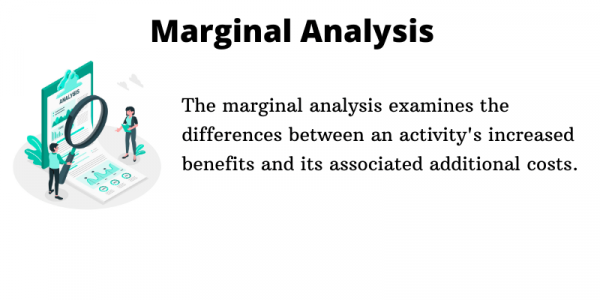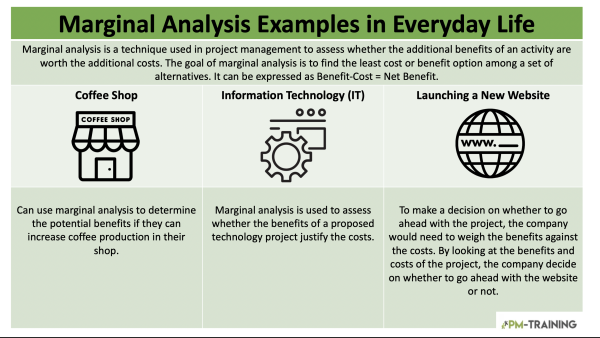Marginal analysis is a technique used in project management to assess whether the additional benefits of an activity are worth the additional costs. The comparison of additional benefits to additional costs is known as the benefit-cost ratio. The goal of marginal analysis is to find the least cost or most benefit option among a set of alternatives and it can be expressed as Benefit-Cost = Net Benefit.
When deciding whether to undertake an activity, managers should always consider the marginal benefits and marginal costs.
The marginal benefits of an activity are the additional benefits that will be gained from undertaking the activity.
The marginal costs of an activity are the additional costs that will be incurred from undertaking the activity.
So, in order to make a decision, managers should compare the marginal benefits of an activity to the marginal costs.
If the marginal benefits are greater than the marginal costs, then the activity should be undertaken. If the marginal benefits are less than the marginal costs, then the activity should not be undertaken.
Marginal analysis is a powerful tool that can be used to make sound decisions about whether to undertake an activity.
When used correctly, it can help managers maximize the benefits of activity while minimizing costs.
For example, marginal analysis is a powerful tool that can be used to assess a wide range of activities, from the purchase of new equipment to the introduction of a new product line. Meaning, where to focus efficiently with the use of resources.
In this article, we will explain what marginal analysis is and how it can be used in project management. We will also provide some examples of its use.

Why Is Marginal Analysis Used?
Project managers use marginal analysis to determine the potential effect of a change on the project.
For example, marginal analysis can be used to identify and assess the potential effect of a change to a project on its costs, schedule, risks, and performance.
It is a powerful tool that can be used to make informed decisions about whether or not to proceed with a proposed change.
There are many benefits of using marginal analysis in project management. It can help project managers to:
- Understand the potential impact of a proposed change on the project
- Make informed decisions about whether or not to proceed with a proposed change
- Identify and assess risks associated with a proposed change
- Mitigate risks by implementing appropriate controls
If you are considering making a change to your project, then the marginal analysis is a tool that you should definitely use as it can help you to understand the potential impact of the change and make an informed decision about whether or not to proceed.
Examples Of Marginal Analysis
To understand Marginal analysis we can take a few marginal analysis examples:
- A coffee shop might use marginal analysis to determine the potential benefits if they can increase coffee production in their shop. So they need to formulate the following:
- Net benefit (amount of revenue in total coffees) =
total benefits (coffees sold) – total costs (what cost to make the coffees - That was easy, right? But what about in Businesses or Projects?
- In information technology (IT), marginal analysis is used to assess whether the benefits of a proposed technology project justify the costs.
- For example, a company may be considering launching a new website. The benefits of the website may include increased sales, better customer service, and improved communication with stakeholders. The costs of the website may include the cost of development, hosting, and maintenance vs rough order of magnitude best guess.
To make a decision on whether to go ahead with the project, the company would need to weigh the benefits against the costs.
This is where marginal analysis comes in. By looking at the benefits and costs of the project, the company can make an informed decision on whether to go ahead with the website or not.
Now let’s see with numbers with a company:
- Understanding a margin is the amount of money that a company has left over after it has paid all of its expenses, let say
- If a company has $100 in revenue and $80 in expenses, then its margin is $20 right? Remember the formula
The margin is also a company’s profit expressed as a percentage of its revenue. In this example, the company’s margin would be 20%.
Companies use margins to measure their financial health and to identify opportunities for improvement
For example, a company with a high margin is usually doing a better job of controlling its expenses than a company with a low margin. Likewise, a company with a declining margin may be losing market share or experiencing other problems.
In order to make sound decisions about which projects to pursue and how to allocate scarce resources, project managers need to perform marginal analysis.
Simply put, here you compare the benefits and costs of alternative courses of action.
The basic marginal analysis formula is:
Benefit-Cost = Net Benefit
This formula can be used to compare different options and choose the option with the highest net benefit.
Just remember when performing marginal analysis, it is important to consider all of the relevant costs and benefits.
This can be a difficult task, as some costs and benefits may be difficult to quantify. However, with careful analysis, marginal analysis can be a powerful tool for making sound decisions about projects.

Cost Benefit Analysis Vs Marginal Analysis
Cost-benefit analysis and marginal analysis are both tools that can be used to make economic decision-making.
They are similar in that they both seek to identify the best course of action by weighing the costs and benefits of each option
However, there are some key differences between the two.
| Marginal Analysis | Cost Benefit Analysis |
|---|---|
| Marginal analysis, on the other hand, looks at the additional benefits and costs of a course of action and decides whether or not the additional benefits are worth the additional costs. | Cost-benefit analysis weighs the costs and benefits of a course of action and chooses the option that leads to the greatest net benefit. |
| The marginal analysis only looks at the incremental costs and benefits. This means that marginal analysis is more focused on the immediate costs and benefits | The cost-benefit analysis looks at the total costs and benefits of a course of action while it takes a more long-term view. |
| Another key difference is that Marginal Analysis does not assign a monetary value to each cost which is way simpler. | Cost-benefit analysis assigns a monetary value to each cost and benefit, making it more accurate but also complex |
Maximizing Marginal Benefit
In order to maximize marginal benefit, it is important to understand the needs of the customer and the goals of the project.
By understanding these factors, you can better tailor the project to meet the needs of the customer and the expectations of the project.
With a clear understanding of the customer and the project, you can easily identify ways to increase marginal benefit.
There are many ways to increase marginal benefit in project management.
- One way is to optimize processes and procedures to ensure that the project is completed on time and within budget.
- Another way is to focus on quality control to ensure that the final product meets or exceeds customer expectations.
- The next one can be by focusing on value-added activities that will have the greatest impact on the project’s success and be critical of it. Ask yourself if you can go beyond the standard.
- And finally, project managers can also work to improve communication and collaboration with proper feedback and understanding of the needs among team members so that everyone is working towards the same goal efficiently.
By following these tips, project managers can increase the chances of success for their projects and, as a result, increase the chances to meet their project completion goals.
FAQs
What is marginal analysis in Project Management?
In project management, marginal analysis is the process of quantifying the benefits and costs associated with an activity in order to make a comparison.
Why is Marginal analysis important for Project managers?
It is a technique that is used to quantify the benefits and costs of a project change. Marginal analysis can be used to assess the impact of a change on the project budget, schedule, scope, or quality. It is a valuable tool that can help project managers make informed decisions about how to best allocate resources.
What is the formula of Marginal Analysis in Project Management?
The basic marginal analysis formula can be expressed as Benefit-Cost = Net Benefit
What are the key differences between Marginal Analysis and Cost Benefit Analysis?
Marginal analysis is a method of decision-making that focuses on the incremental changes that will result from a decision. In other words, it looks at the marginal costs and benefits of a project. Cost-benefit analysis, on the other hand, looks at the total costs and benefits of a project.
